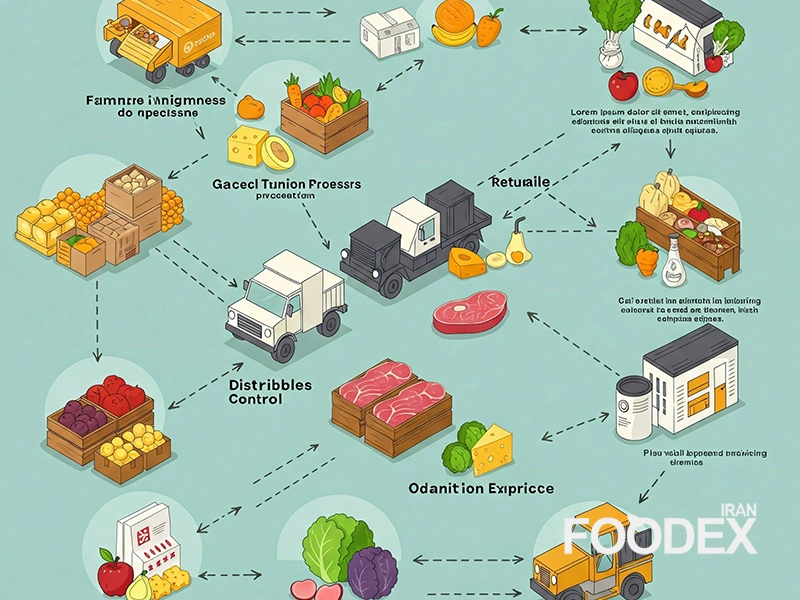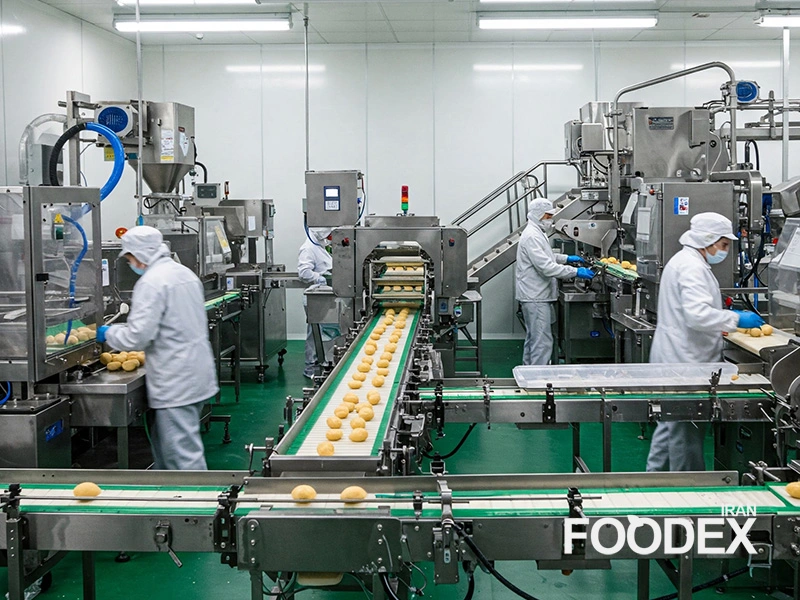In today’s fast-paced Business Environment, effective scheduling is crucial for optimizing supply chain operations and ensuring seamless production and distribution. A typical food manufacturing facility processes thousands of orders daily, distributing them through chain stores. Without precise scheduling, the factory experiences raw material scarcity, delayed deliveries, increased warehousing expenses, and dissatisfied customers. This is where supply chain scheduling becomes essential.
Businesses use scheduling techniques to determine the time sequences and durations for supply chain operations, optimizing production, distribution, and resource management.
This Foodex Magazine article explores the importance of scheduling, management challenges, key terminology, and effective supply chain strategies in the food and agriculture industry.
What Is Scheduling in the Supply Chain?
In supply chain and production management, scheduling determines when activities should start, their order, and duration. Companies need to monitor their packaging materials and raw material stocks while distributing organizational assets, including workforce, facilities, and machinery, to perform operations correctly and when needed.
Supply chain analysts must handle several scheduling types throughout their work.
- Production Scheduling
- Capacity Scheduling
- Workforce Scheduling
- Transportation Scheduling
- Maintenance Scheduling
- Project Scheduling
Yet, all scheduling types focus on individual production systems or supply chain management elements.
The Process of Creating a Scheduling Plan in the Supply Chain
Several necessary points need examination when building an effective scheduling plan.
- Demand levels and production requirements
- Inventory levels of packaging and raw materials
- Effective planning relies on available resources, including skilled workers, experience, and operational equipment.
- Lead times for order fulfillment
- Business operations adhere to their ordered priorities together with their designated delivery timeframes for customers.
- Operational costs and constraints
- Maintenance and repair limitations
Key Steps in Creating a Scheduling Plan
The Schedule Development Process Includes the Following Critical Subsections
The scheduling plan requires the full inventory of essential operations, including production logistics, material acquisition and distribution, and quality management.
Process scheduling requires identifying both essential task order and their related requirements for completion timing.
The schedule development relies on historical data and performance standards to calculate the estimated period needed for each process.
The strategic deployment of resources consists of distributing workforce, equipment, raw materials, and additional fundamental components to their assigned tasks for maximum utility.
The plan includes preparing for unforeseen challenges while also creating backup strategies to handle time delays, customer demand patterns, and supply network breakdowns.
The Importance of Scheduling in Supply Chain Management
Enhancing efficiency and optimizing operations: Proper scheduling enables more efficient production and an improved supply chain.
Reducing delays and improving service levels: Delivering goods and services becomes possible through precise scheduling processes that meet the defined quantity requirements at scheduled timeframes.
Flexibility in responding to demand fluctuations: Businesses can achieve quick market and demand adjustments through a scheduling method that reacts to changing conditions dynamically.
Better inventory and cost management: Proper scheduling maintains optimal inventory levels while reducing storage and shipping costs.
Lower operational costs and increased productivity: Organizations that manage their schedules well reduce their costs related to labor, transportation, production, and overhead expenses.
Rethinking Transportation in the Supply Chain
Models &MethodsStandard Terms in Supply Chain Scheduling
Supply chain scheduling operations include fundamental terms that address scheduling management and its connected procedures.
Basic Scheduling Terms
Bottleneck
When materials, information, and activities encounter restricted flow at any point in the supply chain, it causes slowdowns that lead to overall process delays, referred to as a bottleneck. The term describes limited-capacity resources and processes that produce negative effects on operational output and efficiency levels.
Scheduling
Systematic planning and organizational measures for arranging tasks, activities, and resources enable the attainment of defined goals and target delivery dates. Organizations set specific times for different production stages, transportation, and operational activities to maximize their operational performance while satisfying customer needs.
Scheduling Horizon
The scheduling horizon represents the period that scheduling activities need to cover. Organizations decide between short-term, mid-term, and long-term durations according to their particular requirements.
Scheduling Software
Scheduling software streamlines supply chain operations by optimizing resource management through automated algorithms and real-time data.
Work in Progress (WIP)
The term WIP applies to inventory items and tasks undergoing processing as well as anything in different phases of completion between production stages and supply chain activities. Raw materials, semi-finished products, and manufacturing components form part of the WIP inventory because they are still in the intermediate stages between the original and finished products.
Terms Related to Measurement and Evaluation in Scheduling
Critical Path
The critical path is the sequence of tasks that determines the shortest possible project completion time. It shows the most extended period for task completion through necessary activities that cannot be skipped during the process.
Cycle Time
One cycle of a specific purpose or workflow requires all the cumulative time noted as cycle time. Producers use cycle time to measure the entire duration needed to manufacture one product unit, from raw materials to completion.
Lead Time
Lead time represents the complete duration required for processing orders and products from the beginning to the end of a supply chain operation. The entire process extends from order management through manufacturing and shipping services, including all time-based procedures.
Lead Time Decomposition
Lead time is broken down into key components such as processing, waiting periods, and transportation costs to improve efficiency. This analytical approach allows for the identification of supply chain efficiency.
Lead Time Variability
This definition describes temporary variations in the delivery process and order fulfillment durations. Excessive lead time fluctuation increases system performance risks since it hampers inventory management and customer demand fulfillment.
Production Rate
The number of units that production achieves during set time intervals determines both operational efficiency and production efficiency.
Setup Time
The time between when machines, workstations, and processes need their setup phase to start production of one particular product or batch defines setup time. The reduction of setup times remains essential to enhance operational efficiency when dealing with small-batch manufacturing together with Just-in-Time (JIT) production.
Throughput Time
Flow time is the total duration a product spends in a process from start to completion
Terms Related to Scheduling Methods, Processes, and Tools
Batch Scheduling
Production or processing activities under batch scheduling occur as groups instead of treating each entity as independent. Single-item processing proves inefficient for sectors that require this method of operation.
Capacity Planning
Businesses use capacity planning to measure and enhance their manufacturing abilities while matching them to present-day and expected customer needs. The approach prevents resources from being overloaded or underutilized.
Finite Capacity Scheduling
The scheduling procedure integrates resource-related restrictions into the process to ensure optimal utilization of available machine capacity and workforce capacity, maintaining operational efficiency.
Just-in-Time (JIT) Production
The scheduling system and inventory management concept named JIT functions to provide products precisely at the exact production and delivery moment. The scheduling system achieves two goals: it reduces unnecessary stock and waste and optimizes delivery duration and equipment setup operations while matching production schedules to market requirements.
Material Requirements Planning (MRP)
MRP aims to estimate production requirements by analyzing scheduled production activities against existing inventory levels. This system provides materials availability at predetermined times to prevent material scarcity and unnecessary stock accumulation.
Production Planning
Prospective companies develop complete production designs by allocating resources, setting performance metrics, and using process integration practices to optimize efficiency and satisfy client needs.
Resource Allocation
Resource allocation is the distribution of labor, machinery, and raw materials across different supply chain activities to ensure optimal and efficient resource utilization.
Routing
Supply chain routing determines what order products and orders should move through their entire path.
Sequencing
Supply chain efficiency optimization requires sequencing, which defines how activities will be scheduled and organized according to their priority order.
What Is Production Planning?
A production planning schedule defines which manufacturing activities need to happen, their timeframes, and the necessary resources when producing items in a manufacturing environment. This planning system, which interconnects specified tasks with planning resources and required outputs, provides the roadmap for production activities. Each element is analyzed separately in the following discussion.
Three Key Components of Production Planning
1- What Is Planned
Production planning determines output volumes that flow from market requirements, sales activities, and production scheduling needs. At this point, the analysis generates required production volumes that consider customer demands, delivery parameters, facility constraints, optimal production quantity limits, and inventory requirements.
2- What Is Available
The available manufacturing resources become a critical component of the computation process during production planning. The resources necessary for manufacturing consist of unprocessed materials, components, equipment, and workforce capabilities. The method evaluates when each production input, such as machines, workforce, packaging, and raw materials, will be available to meet manufacturing needs.
3- What Is Required
The planned production volume and resource availability combine to ascertain the necessary elements for manufacturing success. This section outlines every necessary material, component, and specific resource needed in production orders alongside the established operational sequence.
Inventory Planning and Management in the Food Supply Chain
Strategies & Practical ModelsBenefits of Production Planning in Supply Chain Management
1- Ensuring On-Time Production
Production planning clarifies the steps of manufacturing operations and allows the delivery of products according to customer needs. To maintain operational flow and avoid manufacturing slowdowns, a detailed timeline accompanies the execution of the production order.
2- Optimizing Production Resources
Production planning examines current capacities to optimize resource use, which prevents machines and staff from operating at excessive or inadequate levels. This measure results in lower production expenses combined with enhanced operational performance.
3- Improving Inventory Management
The necessary production amounts originate from inventory guidelines to match available operational resources. This planning method helps organizations stay in control of their inventory supply, resulting in perfect stock distributions.
4- Facilitating Coordination Between Departments
The process creates better cooperation between production departments, procurement functions, logistics, and sales units. Departmental communication effectiveness determines how well customers will be satisfied even during unexpected production disruptions.
5- Balancing Supply and Demand
Organizations use production planning to evaluate their capacity for delivering to customers through an assessment that integrates consumer needs and operational capabilities. The system provides organizations with the tools to make knowledgeable production adjustments, make resource allocation choices, and handle orders effectively.
The Role of a Supply Chain Analyst in Production Planning
Supply chain analysts provide essential support to the development and maintenance of production planning systems that manage the operations of both internal and external manufacturers.
The construction of accurate production plans results in improved operational effectiveness, cost reduction, and better customer satisfaction outcomes.
Married to manufacturing control, production planning functions as both an enhancer for production control management and an optimizer of the whole supply chain operation.
Common Challenges in Scheduling within the Supply Chain
Supply chain scheduling is uncertain, requiring analysts to anticipate challenges and adapt quickly. Navigating these complexities requires robust strategies.
Let’s see how Alex, a hypothetical supply chain analyst at “FoodTech,” approaches some typical scheduling problems:
1- Uncertain Demand
When demand patterns fluctuate unpredictably, scheduling becomes difficult, straining resources and impacting production efficiency. These shifts can be driven by seasonality, economic conditions, changing consumer preferences, or unforeseen events.
Alex’s Approach:
He employs forecasting tools that analyze FoodTech’s historical data alongside external variables like market trends and social media sentiment to predict shifts in customer demand for food products.
He collaborates closely with sales and marketing teams, holding regular meetings to gather market intelligence and rapidly adapt the production schedule.
He utilizes flexible planning methods that allow resources to be adjusted according to market needs, whether scaling up production for popular items or reconfiguring lines for new products.
2- Production Capacity Constraints
imited production capacity, equipment shortages, or a lack of skilled labor can create bottlenecks, leading to missed deadlines, higher costs, and customer dissatisfaction. Coordinating machine maintenance and workforce schedules adds another layer of complexity.
How Alex Tackles This:
He performs regular capacity planning, assessing the production capabilities at FoodTech’s facilities.
He implements optimization processes and recommends investments in new technology to alleviate production bottlenecks.
He identifies and vets alternative suppliers or co-manufacturers to provide surge capacity during peak demand periods.
He uses scheduling algorithms and optimization tools to sequence production efficiently and maximize the utilization of available resources.
3- Complex Production Processes
When manufacturing involves numerous steps and interdependencies, coordinating the workflow and managing dependencies can feel like solving a complex puzzle.
Alex’s Strategy:
He implements Manufacturing Execution Systems (MES) to monitor the production process in real-time and manage dependencies between stages.
He leverages Advanced Planning & Scheduling (APS) software, which uses real-time data to automate and optimize scheduling decisions.
Alex recognizes that technology’s effectiveness hinges on data quality, emphasizing the importance of continuous data accuracy.
4- Inventory Management
Balancing inventory levels against the production schedule is a critical challenge. Excess inventory leads to higher holding costs and potential spoilage, while insufficient stock results in shortages, lost sales, and unhappy customers.
Managing the Balance:
He works closely with suppliers, utilizing Vendor-Managed Inventory (VMI) systems where appropriate, allowing suppliers to help optimize inventory levels.
He implements Just-in-Time (JIT) inventory principles to minimize stockpiling and reduce warehousing costs.
Alex understands the need to balance the benefits of lean inventory against the risk of supply chain disruptions.
5- Coordinating with Suppliers
Aligning the production schedule with suppliers’ delivery timelines can be like conducting an orchestra. Differing lead times, transportation delays, and varying supplier capacities complicate this coordination.
Alex’s Coordination Tactics:
He utilizes Collaborative Planning, Forecasting, and Replenishment (CPFR) methods to share demand forecasts and production plans with key suppliers.
He leverages Electronic Data Interchange (EDI) systems for efficient, real-time communication and data exchange with suppliers.
6- Unexpected Disruptions
Events like equipment breakdowns, natural disasters, geopolitical issues, or labor strikes can disrupt the best-laid plans, causing production delays and increasing costs.
Preparing for the Unexpected:
He develops robust contingency plans to enable swift responses when disruptions occur.
He incorporates risk management practices into supply chain processes, regularly assessing vulnerabilities and developing mitigation strategies.
7- Lack of Real-Time Visibility
Without real-time information on inventory levels, resource availability, and order status, scheduling decisions can be inefficient and based on outdated data.
Enhancing Visibility:
He utilizes advanced data analytics platforms to monitor the status of production, inventory, and orders in real-time.
He ensures seamless integration of Enterprise Resource Planning (ERP) systems across the organization, providing departments with access to shared, up-to-date information.
He leverages technologies like Internet of Things (IoT) sensors and RFID tags to gather accurate, real-time data on equipment status and material location.
The Role of a Supply Chain Analyst in the Food and Beverage Industry
Learn MoreFinal Thoughts
In today’s competitive and volatile food and agriculture market, mastering supply chain scheduling is no longer an optional extra, it’s a strategic necessity for survival and sustainable growth. Businesses that meticulously schedule the flow of materials, information, and products not only reduce costs and maximize efficiency but also secure a stronger market position and ensure customer satisfaction by responding effectively to market needs. This is a powerful competitive advantage that can define your success in the industry.
Ready to transform your supply chain with advanced strategies? Foodex is committed to providing the knowledge and tools you need to succeed. Explore our dedicated section in the Foodex Magazine for deeper insights and practical articles on supply chain optimization:
Explore Supply Chain Articles Here
Frequently Asked Questions (FAQs)
1- Why is accurate scheduling especially critical in the food supply chain?
Due to the high perishability of many food products, precise scheduling is vital for maintaining freshness, quality, and safety. It also helps manage demand volatility (e.g., seasonal items), comply with food safety regulations, and minimize waste. Delays in this industry can quickly lead to financial loss and damage brand reputation.
2- What’s the first step a food business should take to improve its scheduling?
The first step is understanding your current state. Gather accurate data on existing processes, including cycle times, supplier lead times, resource capacities, and demand patterns. Then, map your key supply chain processes and identify major bottlenecks (points causing delays). Optimization is difficult without a clear picture of the current situation.
3- Is specialized software necessary for effective supply chain scheduling?
Not strictly necessary, but highly beneficial. For simple operations, basic tools like spreadsheets might suffice initially. However, as complexity grows (more products, orders, wider networks), specialized scheduling software (like Advanced Planning and Scheduling – APS systems or advanced ERP modules) significantly boosts efficiency and accuracy through features like automated optimization, real-time visibility, and scenario simulation.
Ehsan Allahverdi
Executive Manager of Foodex Iran
Marketing Consultant for Leading Food & Beverage Brands
website | linkedin

























